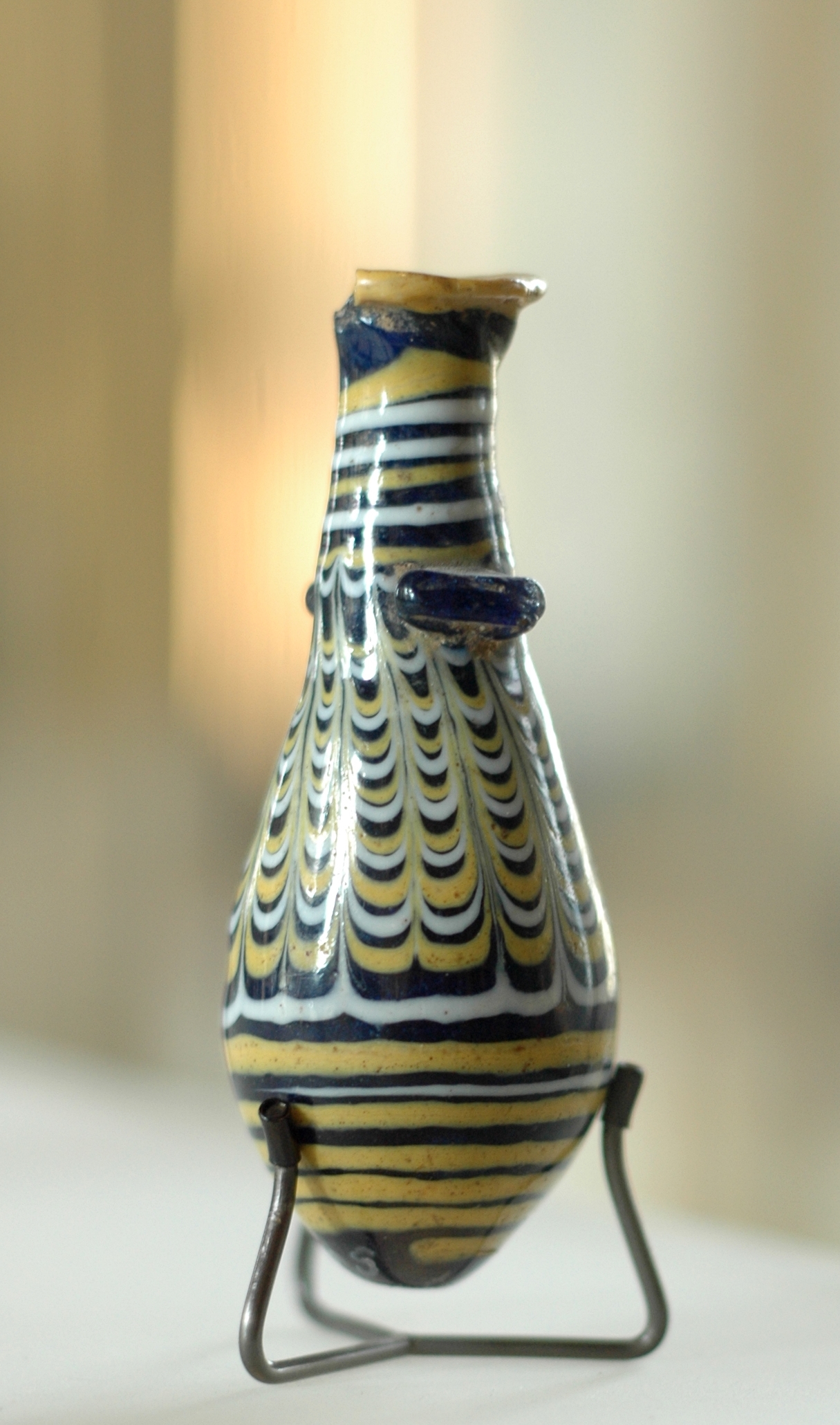Alabastron Italy Louvre S2375.jpg on:
[Wikipedia]
[Google]
[Amazon]
 An alabastron or alabastrum (plural: ''alabastra'' or ''alabastrons''; from the
An alabastron or alabastrum (plural: ''alabastra'' or ''alabastrons''; from the Strong's Greek 211
Matthew 26:7 all having presumably been inspired by or exported from Greece or Egypt. Within a hundred years after arriving in the area, Greek artisans were producing elaborately decorated silver alabastra, long and narrow and in height. The decoration usually involved dividing the body of the vase into four horizontal zones by ornamental bands around it.
 An alabastron or alabastrum (plural: ''alabastra'' or ''alabastrons''; from the
An alabastron or alabastrum (plural: ''alabastra'' or ''alabastrons''; from the Greek
Greek may refer to:
Greece
Anything of, from, or related to Greece, a country in Southern Europe:
*Greeks, an ethnic group.
*Greek language, a branch of the Indo-European language family.
**Proto-Greek language, the assumed last common ancestor ...
) is a small type of pottery
Pottery is the process and the products of forming vessels and other objects with clay and other ceramic materials, which are fired at high temperatures to give them a hard and durable form. Major types include earthenware, stoneware and ...
or glass vessel used for holding oil, especially perfume
Perfume (, ; french: parfum) is a mixture of fragrant essential oils or aroma compounds (fragrances), fixatives and solvents, usually in liquid form, used to give the human body, animals, food, objects, and living-spaces an agreeable scent. Th ...
or massage oils. They originated around the 11th century BC in ancient Egypt as containers carved from alabaster
Alabaster is a mineral or rock that is soft, often used for carving, and is processed for plaster powder. Archaeologists and the stone processing industry use the word differently from geologists. The former use it in a wider sense that include ...
– hence the name – and spread via ancient Greece
Ancient Greece ( el, Ἑλλάς, Hellás) was a northeastern Mediterranean Sea, Mediterranean civilization, existing from the Greek Dark Ages of the 12th–9th centuries BC to the end of Classical Antiquity, classical antiquity ( AD 600), th ...
to other parts of the classical world.
Most types of alabastron have a narrow body with a rounded end, a narrow neck and a broad, splayed mouth. They were often left without handles, but some types were equipped with ear-shaped projections or lugs into which holes were punched. Strings were then put through these holes for easy mobility.
The design of the first Egyptian alabastra was inspired by the palm tree
The Arecaceae is a family of perennial flowering plants in the monocot order Arecales. Their growth form can be climbers, shrubs, tree-like and stemless plants, all commonly known as palms. Those having a tree-like form are called palm ...
, with a columnar shape, a palm capital and a stand. Later designs were made from glass
Glass is a non-crystalline, often transparent, amorphous solid that has widespread practical, technological, and decorative use in, for example, window panes, tableware, and optics. Glass is most often formed by rapid cooling ( quenching ...
decorated with various patterns, such as scallops, festoons or abstract patterns of rings or zigzags.
Around the 7th century BC, alabastra spread to Greece and became an important element of ancient Greek pottery
Ancient Greek pottery, due to its relative durability, comprises a large part of the archaeological record of ancient Greece, and since there is so much of it (over 100,000 painted vases are recorded in the Corpus vasorum antiquorum), it has exe ...
. There were three distinct types of Greek alabastron:
* A basic Corinth
Corinth ( ; el, Κόρινθος, Kórinthos, ) is the successor to an ancient city, and is a former municipality in Corinthia, Peloponnese (region), Peloponnese, which is located in south-central Greece. Since the 2011 local government refor ...
ian bulbous shape standing about tall; a popular design found throughout Greece.
* A long and pointed version commonly seen in eastern Greek, Etruscan __NOTOC__
Etruscan may refer to:
Ancient civilization
*The Etruscan language, an extinct language in ancient Italy
*Something derived from or related to the Etruscan civilization
**Etruscan architecture
**Etruscan art
**Etruscan cities
** Etrusca ...
, and Italo-Corinth
Corinth ( ; el, Κόρινθος, Kórinthos, ) is the successor to an ancient city, and is a former municipality in Corinthia, Peloponnese (region), Peloponnese, which is located in south-central Greece. Since the 2011 local government refor ...
ian pottery.
* An Attic type about long with a rounded base and lugs for carrying purposes.
Alabastra also appeared in many other places in the ancient world, notably Assyria
Assyria ( Neo-Assyrian cuneiform: , romanized: ''māt Aššur''; syc, ܐܬܘܪ, ʾāthor) was a major ancient Mesopotamian civilization which existed as a city-state at times controlling regional territories in the indigenous lands of the ...
, Syria and Palestine,Matthew 26:7 all having presumably been inspired by or exported from Greece or Egypt. Within a hundred years after arriving in the area, Greek artisans were producing elaborately decorated silver alabastra, long and narrow and in height. The decoration usually involved dividing the body of the vase into four horizontal zones by ornamental bands around it.
See also
* Ancient Greek vase painting * Pottery of ancient GreeceReferences
Bibliography
* "Alabastron." ''Encyclopædia Britannica''. 2006 {{Authority control Ancient Greek pot shapes Perfumery Massage Ancient Roman glassware Alabaster